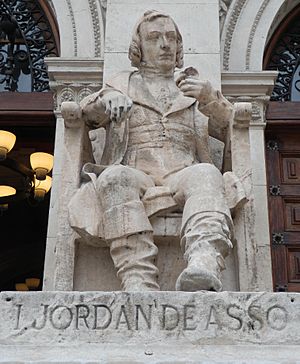Ignacio Jordán Claudio de Asso y del Río facts for kids

Ignacio Jordán Claudio de Asso y del Río (born June 4, 1742 – died May 21, 1814) was a very talented Spanish man. He was a diplomat (someone who represents their country in other nations), a naturalist (someone who studies nature), a lawyer, and a historian. Sometimes, he used a secret name, Melchor de Azagra.
Contents
Early Life and Learning
Ignacio Jordán de Asso came from a noble family and received a great education. He studied Classical Greek and Latin at a school in Zaragoza in 1755. The next year, in 1756, he studied philosophy with the Jesuits in Barcelona.
He then went to the University of Cervera, where he earned a bachelor's degree in 1760. Later, he studied law at the University of Zaragoza, finishing his studies in 1764.
Career as a Lawyer and Diplomat
From 1765 to 1776, Ignacio worked as a jurist, which is a legal expert or lawyer. During this time, he also traveled around Europe for three years. Between 1771 and 1775, he published several large books about law in Madrid, sometimes working with Miguel de Manuel y Rodríguez. These books helped explain the laws of Spain.
In 1776, he started a new career as a diplomat. He served as a consul (a government official who protects their country's citizens and trade in a foreign city) in Dunkirk in 1776. Then, he became a consul general in Amsterdam from 1776 to 1787. After that, he was a consul in Bordeaux from 1787 to 1791.
Contributions to Science and Literature
While working as a diplomat, Ignacio Jordán de Asso was also very interested in science and economics. In Amsterdam, he published important works about the plants (botany), animals (zoology), and rocks (mineralogy) of Aragon, a region in Spain.
Some of his scientific books include:
- Synopsis estirpium indigenarum Aragoniae (1779)
- Mantissa stirpium indigenarum Aragoniae (1781)
- Introductio in oryctographiam, et zoologiam Aragoniae (1784)
- Enumeratio stirpium in Aragonia noviter detectarum (1784)
He was the first person to describe two types of fish: the Argyrosomus regius (a type of drum fish) and the Salaria fluviatilis (a type of blenny fish).
He also translated and published works by many writers and poets from Aragon who lived in the Middle Ages and early modern times. This helped preserve their important writings.
Later Life and Legacy
After his diplomatic work, he became a professor of Chemistry and Botany at the Royal Aragonese Economic Society from 1797 to 1802. He continued to publish many works on farming, plants, natural science, and literature.
During the first and second sieges of Zaragoza, when Napoleon's army attacked the city, Ignacio Jordán de Asso played an important role. He was a legal advisor to José Rebolledo de Palafox, 1st Duke of Saragossa, who led the Spanish resistance. He also wrote articles for the Gazeta extraordinaria de Zaragoza to help the Spanish fight against the French.
After Zaragoza fell to the French, he had to flee to other cities like Murviedro and Palma de Mallorca. When the French occupation ended, he was named a regidor (a type of city council member) of Zaragoza in January 1814. However, he was too old and sick to take on the job. He passed away three months later.
See also
 In Spanish: Jordán de Asso para niños
In Spanish: Jordán de Asso para niños

